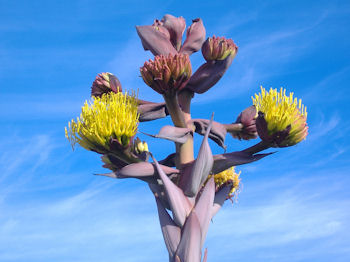 |  |
By Martina

Just now the mescal or coastal agave is blooming. It is easily seen from the roadways, but you cannot fully appreciate it until you stop the car and walk up to it. It is a powerful beauty that amazes the senses. It makes the mind question how anything of this size can push up from the arid foothills of Baja and survive. Yet it is one of the most ancient plants found in Baja and has a rich history. The Mescal produces this towering display only once, and then dies.
The coastal agave blooms from September to May. For many years each plant grows unnoticed. Then it puts all its reserves into the thick shaft that holds the huge bud about to burst. It is a misnomer to call it "Century Plant." The Agavaceae family has nearly 27 species that grow in warm desert and coastal regions. Agave shawii dominates the northern Baja coast down into the desert areas and Bahia de Los Angeles. The true history was never recorded, of course, until the early padres stepped upon the shores of the peninsula and began to record the miracles of its bounty. Every part of the plant was utilized, it was an important source of water during the driest periods of time; it was food, fiber and drink. It still plays a major role in the life of the peninsula ranchos and the Mexican economy.

The mescal is still considered a staple food on the ranchos today. At what is considered the "asparagus stage" the mescal stock is eatable. It is cut before blooming and pit-roasted, requiring several days. Its taste is likened to a coarse, juicy, unsweetened yam. After flowering, this stalk becomes too tough to eat. The body of the mescal is also pit-roasted. The thick spiny leaves are first trimmed (more recently with machetes) and the core dug from the earth. It is known that the first people used oak wood paddles fashioned by hand to do the digging. The core was then thrown onto hot stones. This was covered for several days. A cake made from the roasted and mashed mescal was boiled to make beverages.
Talk about beverages! This is one of the most versatile plants for lively libation there is to be found here. Yes! White lightening mescal to be sure, however here is a lesser known drink called Aguamiel. Aguamiel is the fresh unfermented drink that comes from the mashed stalk. Pulque was the fermented drink of the ancestors that is still well known today and comes from the natural fermentation process. This was first recorded by the early Jesuit accounts. Tequila comes along later with the distillation process. Tequila has a very important role in the Mexican economy today.
The coastal agave is not to be mistaken for the blue agave that is used in making tequila. The Aztecs drank the fermented pulque, from the blue agave, just as the coastal agave was utilized by the people here on the peninsula. However, the blue agave was discovered to be far superior for the distillation process. By 1608 tequila was being produced in an area in Jalisco and a city would grow up around the production named Tequila. Spain's king granted the now famous Cuervo family the first license to commercially make tequila. Now more than 300 million plants are harvested there each year.

Mexico has claimed the exclusive international right to the word "tequila." The United States officially recognizes that spirits called "tequila" can only be produced in Mexico. Although some tequilas have remained as family-owned brands, there are over 100 distilleries making over nine hundred brands of tequila in Mexico. Over 2,000 brand names have been registered. Due to this, each bottle of tequila contains a serial number (NOM) depicting in which distillery the tequila was produced.
The experience of traveling by car down the peninsula can be maximized by Norman Roberts' Baja California Plant Field Guide, published 1989, from which much of the facts and details were learned and shared here. Recently released is a third edition by Jon P. Rebman and Norman Roberts before his death. These books are a traveler's companion guide to not only the plants, but the Baja regions and its history.
Martina's email: mteomaya(at)gmail.com